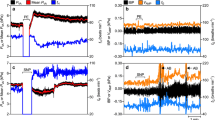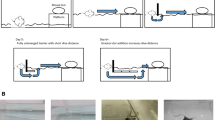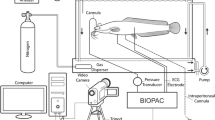Abstract
Much of the neural circuitry controlling respiratory pumping in Aplysia has been well characterized, but the function of this movement is incompletely understood. To gain insight into possible functions of respiratory pumping, responses were examined for a 40 min exposure to two stimuli that modulate the movement: 1) increase and 2) decrease in seawater concentration. Thresholds were present for both stimuli to affect respiratory pumping. Above threshold, there were graded increases in the number of pumps elicited. There were decrements in respiratory pump frequency as a function of time exposed to the stimulus. Increased respiratory pumping did not contribute to volume regulation in response to exposure to altered seawaters, but was associated with increased defensive responses, such as escape locomotion (swimming) and inking. In addition, head shock, a well-established noxious stimulus, elicited temporal patterns of respiratory pumping similar to those elicited by altered seawaters. The data indicate that in our experimental conditions, respiratory pumping is elicited as part of an integrated defensive response to noxious seawaters.
Similar content being viewed by others
References
Alevizos A, Weiss KR, Koester J (1989) SCP-containing R20 neurons modulate respiratory pumping in Aplysia. J Neurosci 9:3058–3071
Alevizos A, Weiss KR, Koester J (1991) Synaptic actions of identified peptidergic neuron R15 in Aplysia. I. Activation of respiratory pumping. J Neurosci 11:1263–1274
Arch S, Lupatkin J, Smock T, Beard M (1980) Evidence for an exocrine function of the Aplysia atrial gland. J Comp Physiol 141:131–137
Audesirk TE (1977) Chemoreception in Aplysia californica. III. Evidence for pheromones influencing reproductive behavior. Behav Biol 20:235–245
Bailey CH, Hawkins RD, Chen M, Kandel ER (1981) Interneurons involved in mediation and modulation of gill withdrawal reflex in Aplysia. IV. Morphological basis of presynaptic facilitation. J Neurophysiol 45:340–360
Bethe A (1930) The permeability of the surface of marine animals. J Gen Physiol 13:437–444
Botzer D, Blumberg S, Ziv I, Susswein AJ (1991) Common regulation of feeding and mating in Aplysia fasciata: Pheromones released by mating and egg-cordons increase feeding behavior. Behav Neural Biol 56:251–261
Byrne JH (1983) Identification and initial characterization of a cluster of command and pattern-generating neurons underlying respiratory pumping in Aplysia californica. J Neurophysiol 49:491–508
Byrne JH, Koester J (1978) Respiratory pumping: neuronal control of a centrally commanded behavior in Aplysia. Brain Res 143:87–105
Byrne JH, Castellucci VF, Kandel ER (1974) Receptive fields and response properties of mechanoreceptor neurons innervating siphon skin and mantle shelf in Aplysia. J Neurophysiol 37:1041–1064
Cleary LJ, Baxter DA, Nazif F, Byrne JH (1991) Neural mechanisms underlying sensitization of a defensive reflex in Aplysia. Biol Bull 180:252–261
Croll RP (1985) Sensory control of respiratory pumping in Aplysia californica. J Exp Biol 117:15–27
Eberly LB, Pinsker HM (1984) Neuroethological studies of reflex plasticity in intact Aplysia. Behav Neurosci 98:609–630
Frost WN, Clark GA, Kandel ER (1988) Parallel processing of short-term memory for sensitization in Aplysia. J Neurobiol 19:297–344
Furgal SM, Brownell PH (1987) Ganglionic circulation and its effects on neurons controlling cardiovascular function in Aplysia californica. J Exp Zool 224:347–363
Hawkins RD, Castellucci VG, Kandel, ER (1981) Interneurons involved in mediation and modulation of gill withdrawal reflex in Aplysia. I. Identification and characterization. J Neurophysiol 45:304–314
Jahan-Parwar B, Fredman SM (1978) Control of pedal and parapodial movements in Aplysia. I. Proprioceptive and tactile reflexes. J Neurophysiol 41:600–608
Jahan-Parwar B, Smith M, von Baumgarten R (1969) Activation of neurosecretory cells in Aplysia by osphradial stimulation. Am J Physiol 216:1246–1257
Kandel ER (1979) Behavioral biology of Aplysia: A contribution to the comparative study of opisthobranch molluscs. WH Freeman, San Francisco
Kanz JE, Quast WD (1990) Respiratory pumping seizures: A newly discovered spontaneous stereotyped behavior pattern in the opisthobranch mollusc Aplysia. J Comp Physiol A 166:619–627
Kanz JE, Quast WD (1992) Respiratory pumping behavior in the marine snail Aplysia californica as a function of ambient hypoxia. Physiol Zool 65:35–54
Koester J (1989) Chemically and electrically coupled interneurons mediate respiratory pumping in Aplysia. J Neurophysiol 62:1113–1126
Koester J, Mayeri E, Liebeswar G, Kandel ER (1974) Neural control of circulation in Aplysia. II. Interneurons. J Neurophysiol 37:476–496
Koester J, Dieringer N, Mandelbaum D (1979) Cellular neuronal control of molluscan heart. Am Zool 19:103–116
Kupfermann I (1974) Dissociation of appetitive and consummatory phases of feeding in Aplysia: A lesion study. Behav Biol 10:89–97
Kupfermann I, Carew TJ (1974) Behavior patterns of Aplysia californica in its natural environment. Behav Biol 12:317–337
Kupfermann I, Kandel ER (1969) Neuronal controls of a behavioral response mediated by the abdominal ganglion of Aplysia. Science 164:847–850
Kupfermann I, Carew TJ, Kandel, ER (1974) Local, reflex and central commands controlling gill and siphon movements in Aplysia. J Neurophysiol 37:996–1019
Kurokawa M, Kuwasawa K (1985a) Electrophysiological studies on the branchial ganglion in the opisthobranch molluscs (Aplysia and Dolabella). J Comp Physiol A 156:35–44
Kurokawa M, Kuwasawa K (1985b) Multimodal motor-innervation of the gill of the aplysiid gastropods, Aplysia kurodai and Aplysia Juliana. J Comp Physiol A 157:483–489
Leonard JL, Martinez-Padron M, Edstrom JP, Lukowiak K (1991) Does altering identified gill motor neuron activity alter gill behavior in Aplysia? In: Kits KS, Boer HH, Joose J (eds) Molluscan neurobiology. North Holland, Amsterdam Oxford New York, pp 30–37
Levy M, Achituv Y, Susswein AJ (1989) Relationship between respiratory pumping and oxygen consumption in Aplysia depilans and Aplysia fasciata. J Exp Biol 141:389–405
Levy M, Markovich S, Susswein AJ (1993) Modulation of respiratory pump rate in freely behaving pairs of Aplysia fasciata. (submitted for publication)
Levy M, Susswein AJ (1990) Learned changes in rate of respiratory pumping in Aplysia fasciata. Behav Neural Biol 54:218–233
Levy M, Susswein AJ (1991) Differential effects of three stimuli producing learned changes of respiratory pump rate in Aplysia. Soc Neurosci Abstr 17:1303
Levy M, Susswein AJ (1992) Conditioned and unconditioned responses to altered seawaters in Aplysia are qualitatively different. Soc Neurosci Abstr 18:15
Levy M, Susswein AJ (1993) Separate neural pathways respond to different noxious stimuli affecting respiratory pump frequency in Aplysia fasciata. Brain Res (accepted for publication)
Mackey SL, Kandel ER, Hawkins RD (1989) Identified serotonergic neurons LCB1 and RCB1 in the cerebral ganglion of Aplysia produce presynaptic facilitation of siphon sensory neurons. J Neurosci 9:4227–4235
Painter SD (1991) Pheromonal attraction and induction of mating behavior in Aplysia. In: Kits, KS, Boer HH, Joose J (eds) Molluscan neurobiology. North Holland, Amsterdam Oxford New York, pp 67–73
Painter SD, Kaiman VK, Nagle GT, Zuckerman RA, Blankenship JE (1985) The anatomy and functional morphology of the large hermaphroditic duct of three species of Aplysia, with special reference to the atrial gland. J Morphol 186:167–194
Peretz B (1969) Central neuron initiation of periodic gill movements. Science 166:1067–1072
Perlman A (1979) Central and peripheral control of siphon-withdrawal reflex in Aplysia. J Neurophysiol 42:510–529
Pinsker HM, Hening WA, Carew TJ, Kandel ER (1973) Long-term sensitization of a defensive withdrawal reflex in Aplysia. Science 182:1039–1042
Sawada M, Blankenship JE, McAdoo DJ (1981) Neural control of a molluscan blood vessel, the anterior aorta of Aplysia. J Neurophysiol 46:967–986
Scemes E, Salomao LC, McNamara JC, Cassola AC (1991) Lack of osmoregulation in Aplysia brasiliana: Correlation with response of R15 to osphradial stimulation. Am J Physiol 260:777–784
Schaefer M, Brownell PH (1986) Modulation of a respiratory motor program by peptide-secreting neurons in Aplysia. J Neurobiol 17:121–126
Skinner TL, Peretz R (1989) Age sensitivity of osmoregulation and its neural correlates in Aplysia. Am J Physiol 256:R989-R996
Stinnakre J, Tauc L (1969) Central neuronal response to the activation of osmoreceptors in the osphradium of Aplysia. J Exp Biol 51:347–361
Susswein AJ, Achituv Y, Markovich S (1987) Aplysia from shallow waters along the coasts of Israel. Cah Biol Mar 28:97–110
Susswein, AJ, Benny M (1985) Sexual behavior in Aplysia fasciata induced by homogenates of the distal large hermaphroditic duct. Neurosci Lett 59:325–330
van Weel PB (1957) Observations on the osmoregulation in Aplysia Juliana Pease (Aplysiidae, Mollusca). Z Vergl Physiol 39:492–506
Walters ET, Erickson MT (1986) Directional control and the functional organization of defensive responses in Aplysia. J Comp Physiol A 159:339–352
Walters ET, Carew TJ, Kandel ER (1981) Associative learning in Aplysia: Evidence for conditioned fear in an invertebrate. Science 211:504–506
Author information
Authors and Affiliations
Rights and permissions
About this article
Cite this article
Levy, M., Susswein, M.O. & Susswein, A.J. Respiratory pumping in Aplysia fasciata as part of an integrated defensive response to increases and decreases in seawater concentration. J Comp Physiol A 172, 749–758 (1993). https://doi.org/10.1007/BF00195400
Accepted:
Issue Date:
DOI: https://doi.org/10.1007/BF00195400




